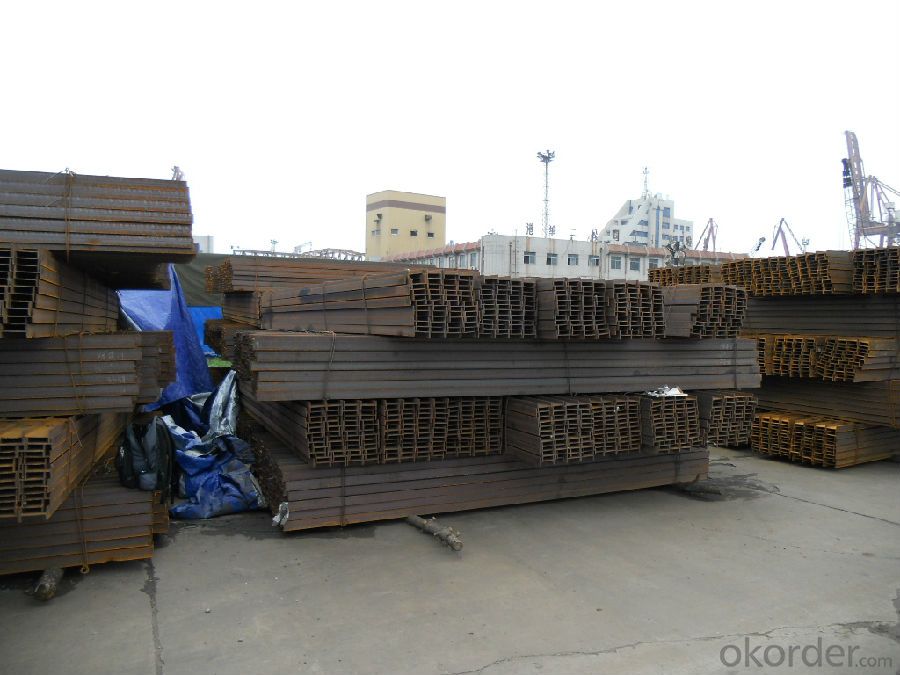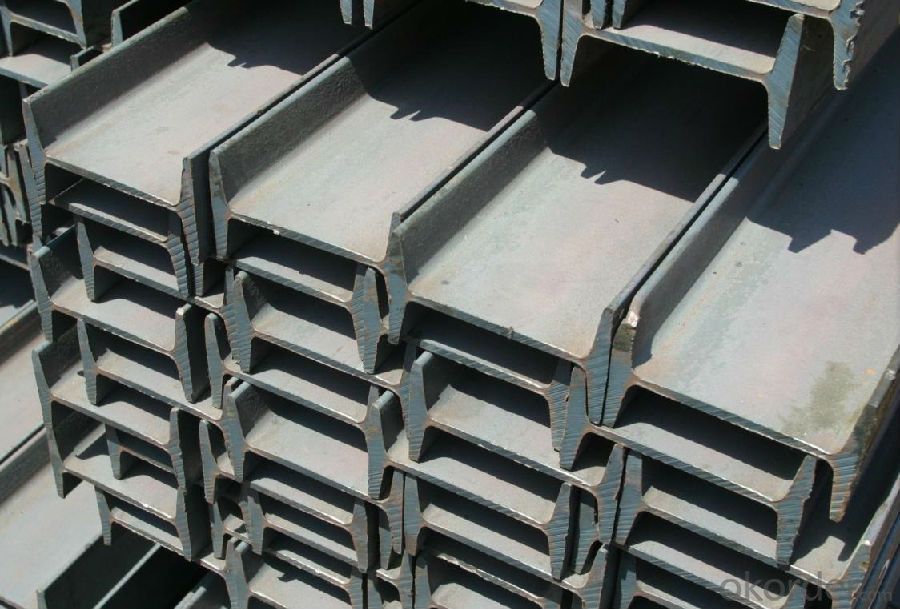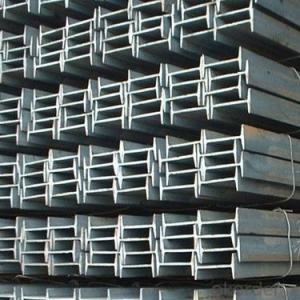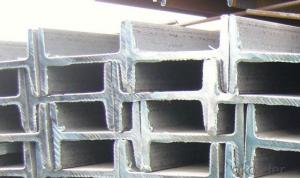European Standard IPE140 with High Quality
- Loading Port:
- Tianjin
- Payment Terms:
- TT OR LC
- Min Order Qty:
- 25 m.t
- Supply Capability:
- 15000 m.t/month
OKorder Service Pledge
OKorder Financial Service
You Might Also Like
Product Description of European Standard IPE140 with High Quality:
Specifications of European Standard IPE140 with High Quality:
1.Standard: EN10025
2.Material: S235JR or Equivalent
3.Length: 6m, 12m
4.Size:
Size (mm) | Mass (kg/m) |
| 140*73*4.7 | 12.9 |
Usage & Applications of European Standard IPE140 with High Quality:
Commercial building structure;
Pre-engineered buildings;
Machinery support structures;
Prefabricated structure;
Medium scale bridges.
Packaging & Delivery of European Standard IPE140 with High Quality:
1. Transportation: the goods are delivered by truck from mill to loading port, the maximum quantity can be loaded is around 40MTs by each truck. If the order quantity cannot reach the full truck loaded, the transportation cost per ton will be little higher than full load.
2. With bundles and load in 20 feet/40 feet container, or by bulk cargo, also we could do as customer's request.
3. Marks:
Color mark: There will be color marking on both end of the bundle for the cargo delivered by bulk vessel. That makes it easily to distinguish at the destination port.
Tag mark: There will be tag mark tied up on the bundles. The information usually including supplier logo and name, product name, made in China, shipping marks and other information request by the customer.
If loading by container the marking is not needed, but we will prepare it as customer's request.
FAQ:
We have organized several common questions for our clients, may help you sincerely:
1. How to inspect the quality?
We have a professional inspection group which belongs to our company. We resolutely put an end to unqualified products flowing into the market. At the same time, we will provide necessary follow-up service assurance.
We have established the international advanced quality management system,every link from raw material to final product we have strict quality test;We resolutely put an end to unqualified products flowing into the market. At the same time, we will provide necessary follow-up service assurance.
2. Is there any advantage about this kind of product?
Steel I beam bar IPE has a reduced capacity in the transverse direction, and is also inefficient in carrying torsion, for which hollow structural sections are often preferred.
Images of European Standard IPE140 with High Quality:


*If you would like to get our price, please inform us the size, standard/material and quantity. Thank you very much for your attention.
- Q:How do steel I-beams perform in terms of long-term deflection?
- Steel I-beams perform very well in terms of long-term deflection. Due to their high tensile strength and stiffness, they are less prone to sagging or bending over time compared to other materials. This makes them reliable and a popular choice for structural applications where minimal deflection is desired.
- Q:Can steel I-beams be spliced together?
- Yes, steel I-beams can be spliced together. Splicing refers to the process of joining two or more beams end-to-end to create a longer beam. This can be done using various methods such as welding, bolting, or using splice plates. Splicing is commonly done in construction projects where longer beams are required to support larger spans or loads. However, it is important to ensure that proper engineering practices and guidelines are followed during the splicing process to maintain structural integrity and safety.
- Q:How do you calculate the deflection of a steel I-beam?
- The deflection of a steel I-beam can be calculated using the principles of structural engineering and mechanics. The deflection of a beam refers to the amount of bending or flexing that occurs under an applied load. It is an important factor to consider in designing structures to ensure their stability and safety. To calculate the deflection of a steel I-beam, the following steps can be followed: 1. Determine the load: First, the type and magnitude of the load acting on the beam must be identified. This could be a concentrated load, uniformly distributed load, or a combination of both. 2. Calculate the reaction forces: The reaction forces at the supports of the beam need to be determined. This can be done by considering the equilibrium of forces and moments acting on the beam. 3. Determine the bending moment: The bending moment at any point along the length of the beam can be calculated using the principles of statics. This is done by considering the distribution of the applied load and the geometry of the beam. 4. Find the moment of inertia: The moment of inertia is a property of the beam that describes its resistance to bending. It depends on the shape and dimensions of the cross-section of the beam. The moment of inertia can be determined using standard engineering reference tables or by using formulas specific to the shape of the I-beam. 5. Apply the beam deflection formula: The beam deflection formula varies depending on the type of load and the support conditions of the beam. For a simply supported beam under a concentrated load at the center, the formula for deflection (δ) is given by δ = (5FL^4) / (384EI), where F is the applied load, L is the length of the beam, E is the modulus of elasticity of the steel, and I is the moment of inertia. 6. Calculate the deflection: Using the values obtained from the previous steps, the deflection of the steel I-beam can be calculated. This will give an indication of how much the beam will bend or flex under the applied load. It is important to note that this is a simplified explanation of the calculation process, and there are additional factors that may need to be considered, such as beam supports, structural connections, and other loads acting on the beam. Consulting with a structural engineer or referring to relevant design codes and standards is recommended to ensure accurate and safe calculations.
- Q:Can steel I-beams be used in stadiums or arenas?
- Steel I-beams are indeed suitable for use in stadiums or arenas. These large structures often utilize steel I-beams in their construction because of their impressive strength, durability, and versatility. With their ability to bear heavy loads, steel I-beams are perfect for the expansive areas found in stadiums and arenas. They provide essential structural stability and can withstand the dynamic forces exerted by substantial crowds, equipment, and sporting events. Moreover, steel I-beams offer the advantage of design flexibility, enabling architects and engineers to construct distinctive and visually captivating edifices. Ultimately, the exceptional structural properties and ability to meet the rigorous demands of these vast facilities make steel I-beams a highly favored option for stadiums and arenas.
- Q:How do steel I-beams contribute to the overall energy efficiency of a structure?
- Several factors contribute to the overall energy efficiency of a structure when using steel I-beams. Firstly, the durability and long lifespan of steel make it an ideal material for construction. This means that buildings constructed with steel I-beams require less maintenance and repairs over time, resulting in reduced energy consumption and costs associated with upkeep and renovations. In addition, steel I-beams have excellent load-bearing capabilities, allowing for larger spans and open floor plans. This means that fewer beams are needed to support the structure, resulting in reduced material usage and lower energy requirements during manufacturing and transportation. Moreover, steel is highly recyclable, and at the end of their lifespan, steel I-beams can be easily repurposed or recycled. Recycling steel requires significantly less energy compared to producing new steel, resulting in reduced energy consumption and greenhouse gas emissions. Furthermore, steel I-beams are often used in combination with other energy-efficient building components, such as insulated panels or double-glazed windows. This integration improves the overall thermal performance of the structure by reducing heat transfer, minimizing energy losses, and enhancing insulation. Lastly, steel I-beams can be designed to accommodate various energy-efficient systems, such as solar panels or geothermal heat pumps. These systems can be seamlessly integrated into the structure, further reducing energy consumption by providing renewable energy sources or utilizing the earth's natural heat. In conclusion, by incorporating steel I-beams into the design and construction of a building, energy consumption, costs, and environmental impact can be significantly reduced. The durability, load-bearing capabilities, recyclability, compatibility with energy-efficient components, and ability to accommodate sustainable technologies make steel I-beams an excellent choice for enhancing the energy efficiency of structures.
- Q:Can steel I-beams be used for stadiums and arenas?
- Yes, steel I-beams can be used for stadiums and arenas. They are commonly used in the construction of large structures due to their strength, durability, and ability to support heavy loads. Steel I-beams provide structural integrity and flexibility, making them an ideal choice for stadiums and arenas that require wide open spaces, long spans, and high seating capacities.
- Q:Is the material of steel I-beam manganese steel?
- H type I-beam is also called wide flange I-beam, HW, HM, HN originated from European standards, HEB is the German standard of I-beam, of which HW, HN I-beam has been widely used in our country and production. HEA HEB HEM will be seen on many German designs and is hard to buy on the domestic market. In the domestic steel structure engineering, if the quantity is few, then may use the specification steel plate to carry on the welding splicing. In the case of large quantities, it is usually considered to use mechanical properties comparable to those of HW and HN steel.HW is mainly used for steel reinforced concrete frame column steel column, also known as rigid steel column; in steel structure is mainly used for the columnHM steel height and flange width ratio of about 1.33~~1.75, mainly in the steel structure used as steel frame column, in the frame structure under dynamic load frame frame, for example: equipment platformHN steel height and flange width ratio greater than or equal to 2; used mainly for beamsThe use of ordinary I-beam is equivalent to HN steel;
- Q:Can steel I-beams be used in water treatment plant construction?
- Yes, steel I-beams can be used in water treatment plant construction. They offer structural strength and durability, making them suitable for supporting heavy loads and resisting corrosion in the water treatment environment.
- Q:What are the potential hazards associated with steel I-beam installation?
- When installing steel I-beams, there are various hazards that must be considered. To begin with, mishandling the sheer weight of these beams can be extremely dangerous. They can weigh hundreds of pounds or more, and if they are not secured properly during installation, they can fall and cause severe injuries or even fatalities to workers or bystanders. Therefore, it is crucial to use appropriate lifting equipment and follow proper safety protocols to ensure that steel I-beams are handled and installed safely. Moreover, the installation process itself can be hazardous. Steel I-beams are often installed at elevated heights, increasing the risk of falls. To prevent this, workers must be equipped with fall protection gear, such as harnesses and safety nets, and proper scaffolding or platforms should be used to provide a stable work surface. Additionally, workers should receive training on proper lifting techniques and be mindful of potential pinch points or crush hazards during installation. Another hazard associated with steel I-beam installation is the potential for structural collapse. If the beams are not aligned, secured, or supported correctly, it can lead to catastrophic structural failure. Therefore, it is essential to have a qualified engineer or structural specialist oversee the installation process to ensure that all load-bearing requirements are met and that the beams are installed accurately. Lastly, there may be additional hazards specific to the installation environment. For instance, if the installation is being done in a confined space or an area with limited ventilation, there may be risks related to poor air quality or exposure to hazardous substances. Hence, it is important to evaluate and mitigate these potential hazards before commencing the installation process. In conclusion, the hazards associated with steel I-beam installation emphasize the importance of thorough planning, training, and adherence to safety protocols. By following best practices and ensuring that all necessary safety measures are in place, the risks can be minimized, and the installation process can be completed safely and efficiently.
- Q:What are the common methods of connecting steel I-beams to other structural elements?
- There are several common methods for connecting steel I-beams to other structural elements. Some of the most frequently used methods include welding, bolting, and using specialized connectors such as beam clamps or beam hangers. These methods ensure a strong and secure connection between the steel I-beams and other structural elements, allowing for a robust and reliable overall structure.
1. Manufacturer Overview |
|
|---|---|
| Location | |
| Year Established | |
| Annual Output Value | |
| Main Markets | |
| Company Certifications | |
2. Manufacturer Certificates |
|
|---|---|
| a) Certification Name | |
| Range | |
| Reference | |
| Validity Period | |
3. Manufacturer Capability |
|
|---|---|
| a)Trade Capacity | |
| Nearest Port | |
| Export Percentage | |
| No.of Employees in Trade Department | |
| Language Spoken: | |
| b)Factory Information | |
| Factory Size: | |
| No. of Production Lines | |
| Contract Manufacturing | |
| Product Price Range | |
Send your message to us
European Standard IPE140 with High Quality
- Loading Port:
- Tianjin
- Payment Terms:
- TT OR LC
- Min Order Qty:
- 25 m.t
- Supply Capability:
- 15000 m.t/month
OKorder Service Pledge
OKorder Financial Service
Similar products
New products
Hot products
Related keywords





























